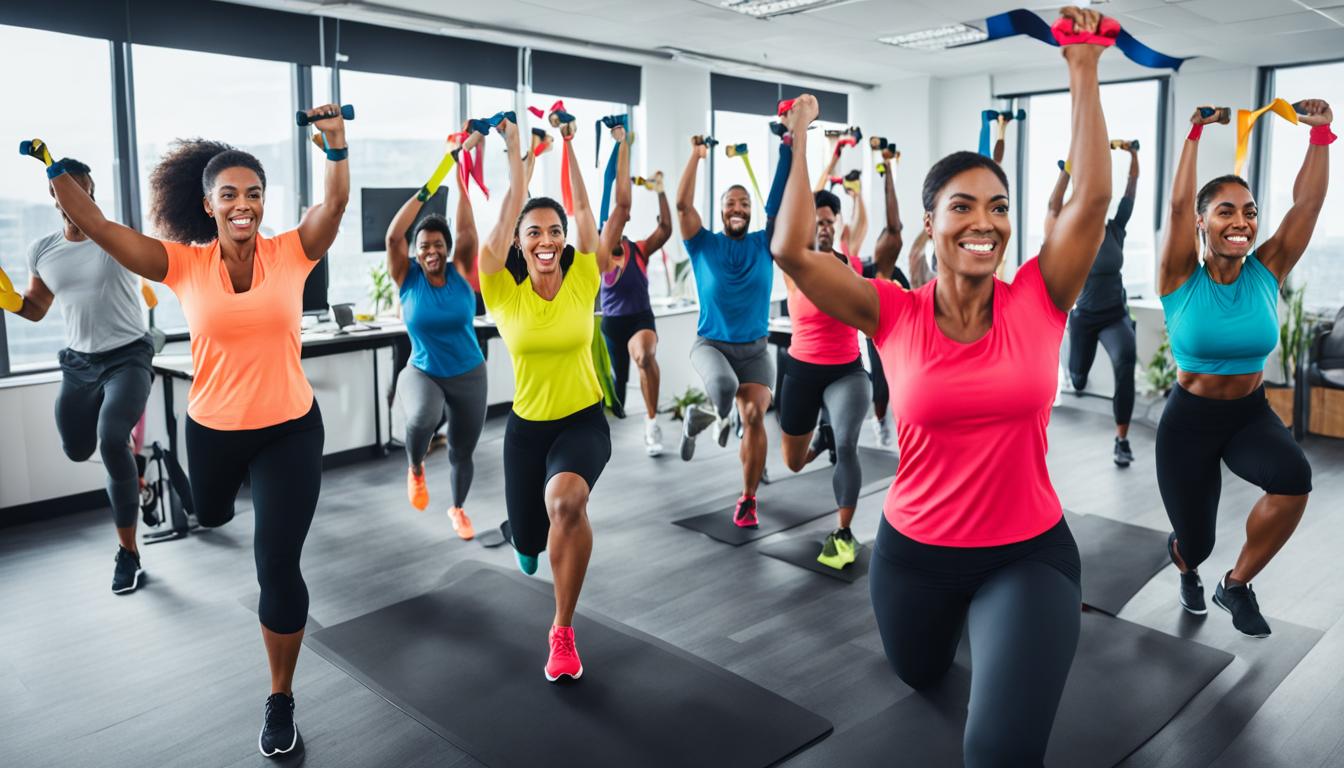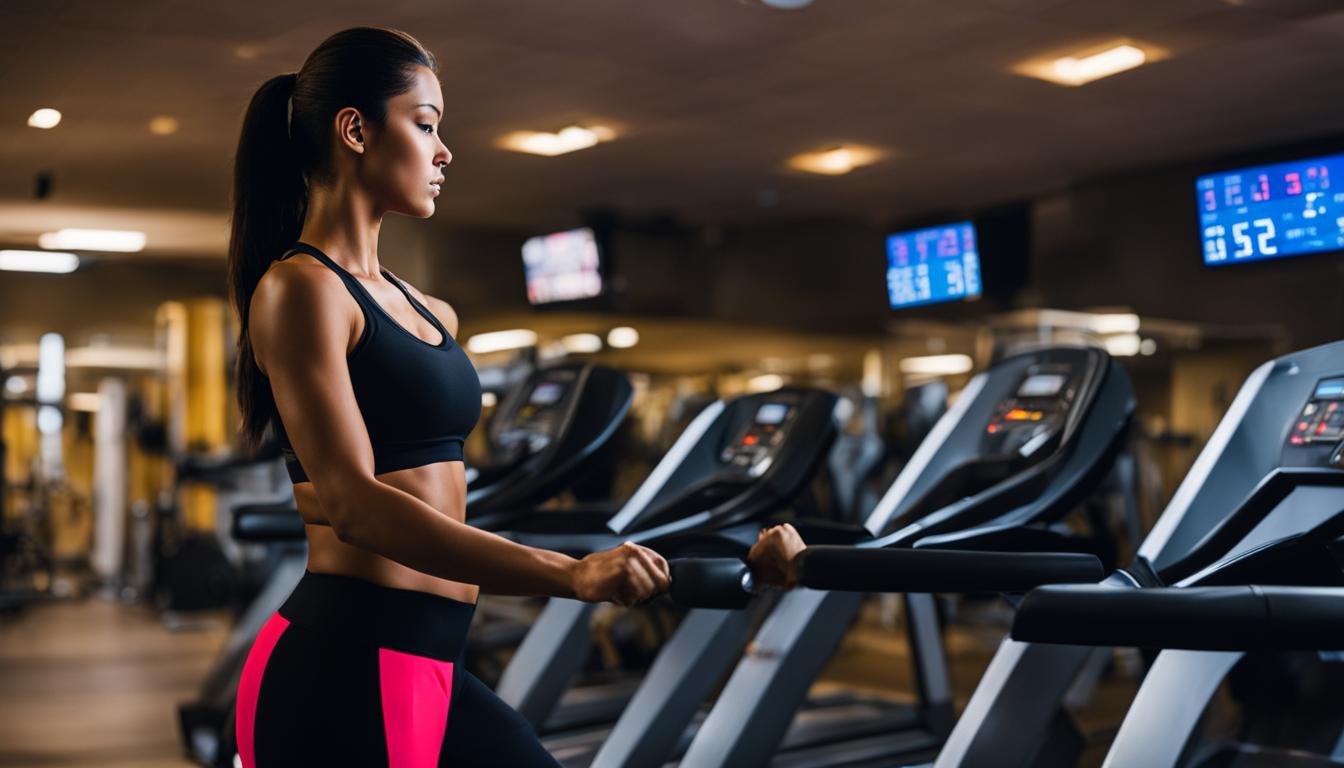Burning fat doesn’t have to be limited to the gym. With these office-friendly fat-burning exercise routines, you can boost your metabolism and shed pounds right at your desk. These exercises can be done with minimal equipment and are designed to target various muscle groups, including the quads, hamstrings, core, hip flexors, chest, shoulders, and triceps. By incorporating these exercises into your workday, you can combat the health risks associated with prolonged sitting and improve your overall fitness.
Key Takeaways:
- Office-friendly fat-burning exercise routines can help boost metabolism and promote weight loss.
- These exercises target multiple muscle groups, including the quads, hamstrings, core, chest, shoulders, and triceps.
- By incorporating these exercises into your workday, you can combat the negative effects of prolonged sitting and improve your overall fitness.
- Remember to consult with a healthcare professional before starting any new exercise routine.
- Make sure to listen to your body and take breaks when needed.
Seated Leg Lifts
Seated leg lifts are a great way to strengthen your legs and core while sitting at your desk. To perform seated leg lifts, sit on the edge of your chair and straighten one leg, lifting it slightly so your thigh is off the chair. This exercise targets the muscles in your lower legs and can help improve balance, stabilization, and hip strength.
Incorporating seated leg lifts into your office exercise routine can help tone your legs and prevent muscle imbalances from prolonged sitting.
| Benefits of Seated Leg Lifts: | How to Perform Seated Leg Lifts: |
|---|---|
| – Strengthening leg muscles | – Sit on the edge of your chair |
| – Improving balance and stabilization | – Straighten one leg |
| – Enhancing hip strength | – Lift the leg slightly off the chair |
| – Toning the legs | – Hold for a few seconds |
| – Preventing muscle imbalances | – Repeat with the other leg |
Chair Swivels
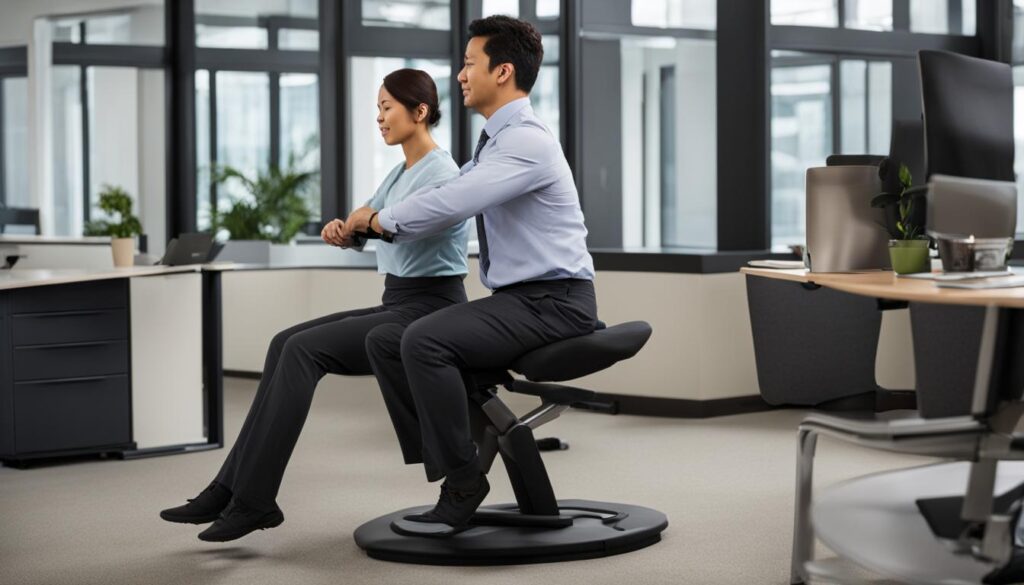
Looking to work your abs while sitting at your desk? Chair swivels are a fun and effective exercise that targets your core muscles. By incorporating chair swivels into your office workout routine, you can improve your core strength and stability.
To perform chair swivels, simply hold onto the edge of your desk and swivel your chair from side to side. This motion engages your abdominal muscles and provides an excellent workout for your core.
Chair swivels are a low-impact exercise that can be easily integrated into your workday. You can perform this exercise during short breaks or whenever you feel the need to engage your abs and stretch your body.
Regularly incorporating chair swivels into your office exercise routine can help strengthen your abs, improve your posture, and prevent back pain caused by sitting for long periods. Plus, it’s a fun way to add movement and exercise to your workday without leaving your desk.
Tips for Effective Chair Swivels:
- Start with a slow and controlled motion, gradually increasing the speed as you become more comfortable.
- Keep your core engaged throughout the exercise to maximize the benefits.
- Focus on using your abdominal muscles to initiate the swiveling motion, rather than relying solely on momentum.
- Breathe deeply and maintain proper posture throughout the exercise.
- Feel free to experiment with different swiveling techniques to target different areas of your core.
Remember, consistency is key when it comes to seeing results. Aim to incorporate chair swivels into your daily office routine and watch your abdominal muscles strengthen over time.
Chair swivels are a convenient and effective way to work your abs without leaving your desk. Incorporate this engaging exercise into your office workout routine for a stronger core and improved stability.
| Benefits of Chair Swivels | How to Perform Chair Swivels |
|---|---|
| Targets core muscles | Hold onto the edge of your desk and swivel your chair from side to side. |
| Improves core strength and stability | Engage your abdominal muscles to initiate the swiveling motion. |
| Enhances posture | Maintain proper posture and breathe deeply throughout the exercise. |
| Prevents back pain caused by prolonged sitting | Incorporate chair swivels into your daily office routine for consistent results. |
Desk Push-ups
Looking to strengthen your upper body and target your chest muscles without leaving your desk? Desk push-ups are the perfect solution. This simple yet effective exercise engages multiple muscle groups, including your chest, shoulders, and triceps, helping you build upper body strength and endurance. Here’s how to perform desk push-ups:
- Stand up and place your hands on the edge of your desk. Make sure your hands are slightly wider than shoulder-width apart.
- Lean forward, keeping your body in a straight line from head to toe.
- Lower your chest towards the desk, bending your elbows as you go down.
- Once your chest is close to the desk, push back up to an extended arm position.
- Repeat for the desired number of repetitions.
Desk push-ups are a convenient and effective way to incorporate upper body exercises into your office workout routine. They can be done anytime, anywhere, and require minimal equipment. Add desk push-ups to your routine and start building strength and definition in your chest muscles today.
Tips for Perfect Desk Push-ups
- Keep your core engaged and your body in a straight line throughout the exercise.
- Breathe in as you lower your chest towards the desk, and exhale as you push back up.
- If you’re new to push-ups, you can start with a modified version by keeping your knees on the ground instead of extending your legs.
- Gradually increase the number of repetitions and sets as you get stronger.
Desk push-ups are a great way to target your chest and upper body muscles without leaving your desk. It’s a versatile exercise that can be modified to suit different fitness levels. Incorporate desk push-ups into your office workout routine and feel the burn in your chest, shoulders, and triceps.
So, the next time you find yourself sitting for long periods at your desk, take a break and perform a set of desk push-ups. Your chest muscles will thank you!
Chair Leg Extensions
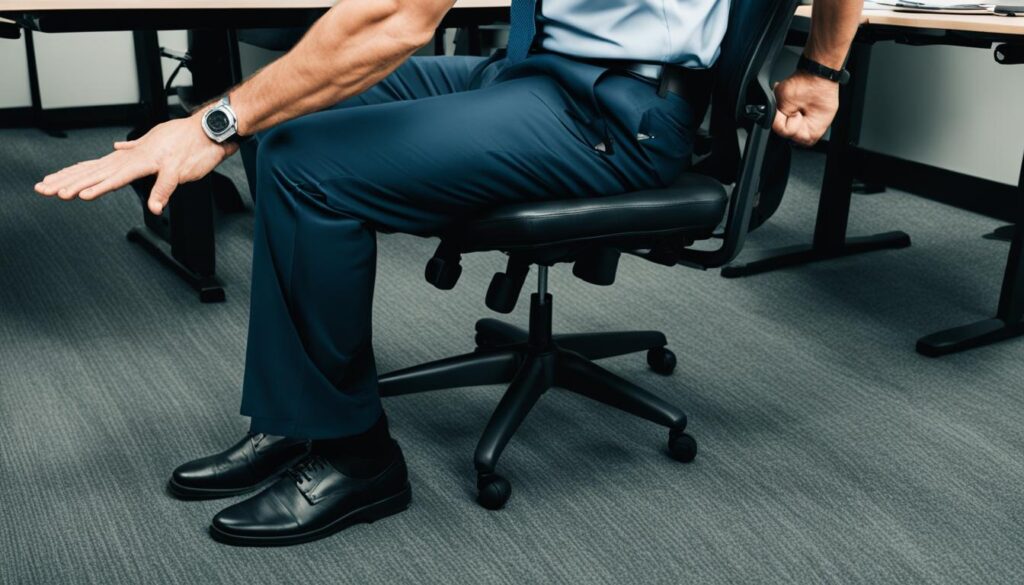
Chair leg extensions are a simple exercise that targets the quadriceps, the muscles in the front of your thighs. To perform chair leg extensions, sit on the edge of your chair and extend your legs to roll backwards. This exercise is great for building strength and toning your lower body. By incorporating chair leg extensions into your office workout routine, you can strengthen your quads and improve your leg strength and stability.
Benefits of Chair Leg Extensions:
- Targets the quadriceps for stronger, toned thighs
- Improves lower body strength and stability
- Can be easily incorporated into your office exercise routine
Enhance your leg workouts and maintain your fitness goals even while at work with chair leg extensions. Get ready to feel the burn!
Chair Leg Curls
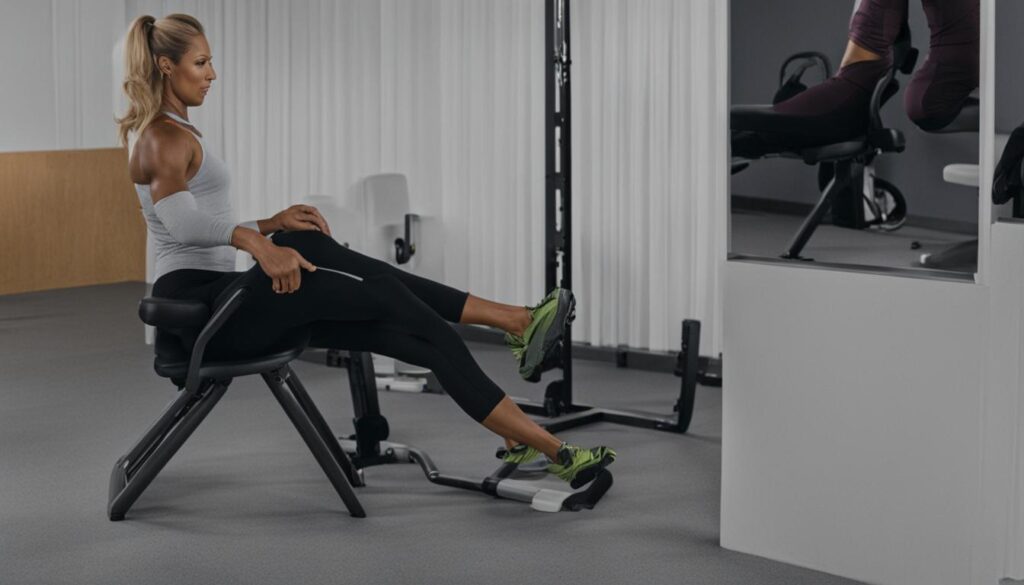
Chair leg curls are an effective exercise for targeting the hamstrings, the muscles on the back of your thighs. To perform chair leg curls, sit on the edge of your chair and curl your legs to roll forward. This exercise can help strengthen the hamstrings, improve leg strength, and prevent muscle imbalances.
By incorporating chair leg curls into your office exercise routine, you can improve the strength and flexibility of your hamstrings and enhance your overall lower body fitness.
Benefits of Chair Leg Curls:
- Targets the hamstrings for better muscle strength and development
- Improves leg stability and prevents muscle imbalances
- Enhances lower body fitness and performance
- Can be done discreetly at your desk during work breaks
Chair leg curls are especially beneficial for individuals who have limited time for exercise or prefer office-friendly workouts. By incorporating this exercise into your routine, you can effectively work your hamstrings and improve your overall lower body strength and flexibility, all from the comfort of your office chair.
Walking Breaks

Looking for a simple and effective way to stay active during your workday? Incorporating walking breaks into your office routine can do wonders for your physical and mental well-being. Not only does walking increase blood flow and improve circulation, but it also boosts energy levels, helping you stay focused and productive.
Benefits of Walking Breaks
Walking breaks provide numerous benefits for your workplace fitness:
- Increased Physical Activity: Taking short walks around the office building or using the stairs instead of the elevator helps you incorporate more physical activity into your day.
- Improved Blood Flow and Circulation: Walking stimulates blood flow, helping to nourish your muscles and organs while removing waste products.
- Boosted Energy Levels: Moving your body and getting fresh air can help combat feelings of fatigue and improve your overall energy levels.
- Reduced Health Risks: Regular walking breaks can help counteract the negative effects of prolonged sitting, reducing the risk of conditions such as heart disease, diabetes, and obesity.
By taking just a few minutes every hour to go for a walk, you can make a significant difference in your overall fitness. Whether it’s a quick stroll around the office or a brisk walk outside, every step counts towards a healthier you.
Fitting Walking Breaks into Your Office Routine
Here are some tips to help you incorporate walking breaks into your workday:
- Schedule Regular Breaks: Set reminders on your phone or computer to prompt you to take short walks throughout the day.
- Use the Buddy System: Encourage your colleagues to join you for walking breaks, making them more enjoyable and motivating.
- Explore Different Routes: Take advantage of nearby parks or paths to make your walks more interesting and engaging.
- Make the Most of Lunch Breaks: Instead of sitting at your desk, use your lunch break to go for a longer walk. It’s a great way to reset your mind and get some exercise.
Remember, even small bouts of movement can make a big difference in your overall fitness. So, lace-up your walking shoes and take that first step towards a healthier and more active workday!
Can the Same Fat-Burning Workout Routines Be Effective for Night Shift Workers and Daytime Office Workers?
Yes, the same optimal fatburning workouts can be effective for both night shift workers and daytime office workers. The key is to find a workout routine that fits into your schedule and keeps you motivated. Consistency is key for achieving fat-burning results, regardless of your work schedule.
Standing Desk Exercises
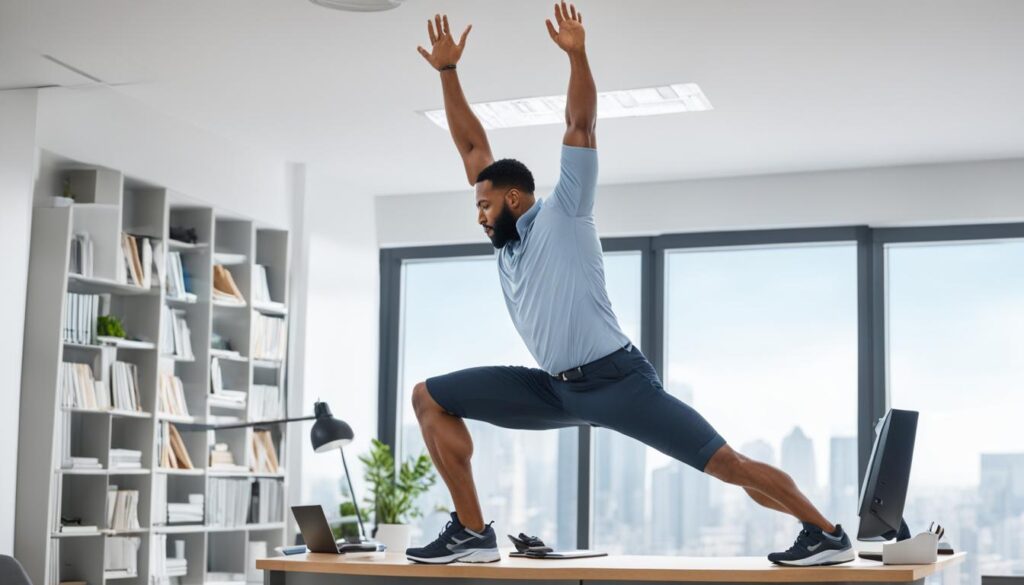
If you have a standing desk, you have a unique opportunity to incorporate exercises into your work routine. As you stand upright, you can engage in various exercises that target different muscle groups, helping you to improve your overall fitness and well-being.
Lunges
Lunges are a fantastic standing desk exercise that work your lower body muscles, including your quadriceps, hamstrings, and glutes. To perform a lunge, step forward with one leg, lowering your body until both knees are at a 90-degree angle. Alternate legs and repeat for a set number of reps or time.
Squats
Squats are an excellent exercise to strengthen your lower body and core. Start by standing with your feet shoulder-width apart, and then bend your knees and hips, lowering your body as if you were sitting back into an imaginary chair. Keep your back straight and your weight in your heels. Return to the starting position and repeat for a set number of reps or time.
Calf Raises
Calf raises can help strengthen your calf muscles while standing at your desk. Begin by standing with your feet hip-width apart and rise up onto the balls of your feet, lifting your heels off the ground. Hold for a moment and then lower your heels back down. Repeat for a set number of reps or time.
Standing Leg Lifts
Standing leg lifts are an excellent exercise to target your hip flexors and improve balance. Stand straight and lift one leg straight out in front of you, keeping it as straight as possible. Hold for a moment and then lower your leg back down. Repeat with the other leg for a set number of reps or time.
By incorporating these standing desk exercises into your work routine, you can promote workplace fitness, burn calories, and strengthen your muscles. These exercises are a convenient and effective way to add physical activity to your day without leaving your desk.
Proper Posture and Ergonomics
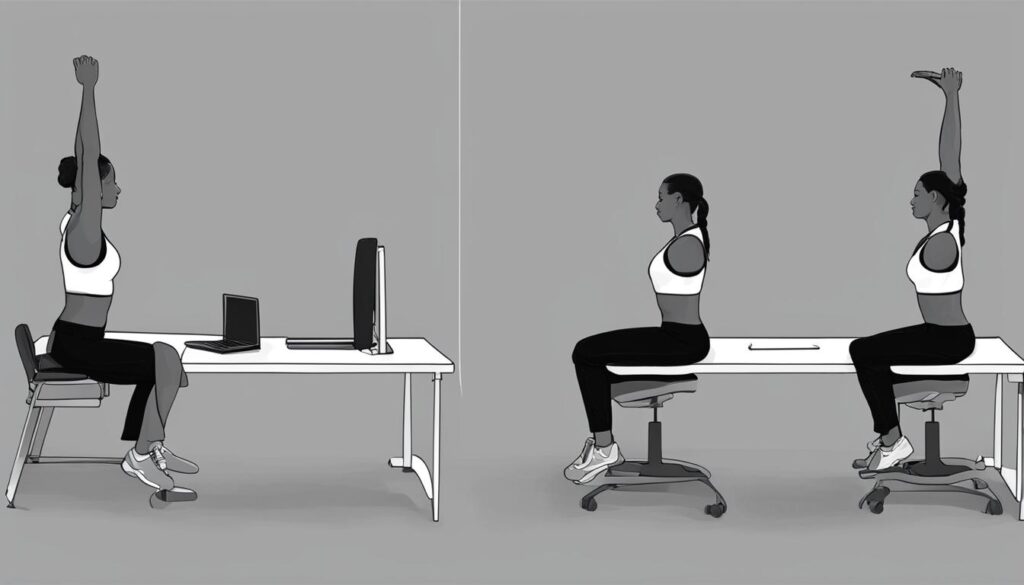
Maintaining proper posture and practicing good ergonomics are essential for preventing musculoskeletal issues and promoting overall well-being in the office.
When it comes to your desk setup, pay attention to the following:
- Chair height: Adjust your chair so that your feet are flat on the floor and your knees are at a 90-degree angle. This promotes proper blood circulation and reduces strain on your lower back.
- Desk height: Position your desk at a height that allows your forearms to be parallel to the floor when typing, ensuring a comfortable typing position and reducing the risk of wrist and shoulder pain.
- Computer monitor position: Place your monitor directly in front of you, about an arm’s length away. Position it at eye level or slightly below to avoid straining your neck and upper back.
While sitting at your desk, remember to:
- Sit with proper posture: Keep your back straight, shoulders relaxed, and chin parallel to the floor. Avoid slouching or hunching over your desk, as this can lead to back and neck pain.
- Take breaks: Stand up and stretch every 30 minutes or so. Walk around the office or perform desk exercises to alleviate muscle tension and promote blood circulation.
Engaging in exercises that promote good posture can also be beneficial. Try incorporating these exercises into your daily routine:
- Shoulder rolls: Sit up straight, relax your shoulders, and roll them backward in a circular motion. Repeat this exercise several times to release tension in your shoulder and upper back muscles.
- Neck stretches: Gently tilt your head to one side, bringing your ear closer to your shoulder. Hold for a few seconds, then repeat on the other side. This exercise helps relieve neck stiffness and improves flexibility.
By maintaining proper posture, implementing ergonomic principles, and incorporating posture-promoting exercises, you can minimize the risk of discomfort and injuries associated with prolonged sitting. Prioritize your workplace health and well-being by giving attention to your posture and ergonomics.
Expert Tip:
“Maintaining proper posture and good ergonomics is crucial for avoiding musculoskeletal issues. Remember to adjust your chair, desk, and monitor to promote a comfortable and ergonomic workspace. Regularly practicing exercises that promote good posture can further enhance your spinal alignment and overall well-being.”
Conclusion
Incorporating office-friendly fat-burning exercise routines into your workday can have numerous benefits for your physical and mental well-being. By utilizing exercises like seated leg lifts, chair swivels, desk push-ups, chair leg extensions, and chair leg curls, you can target multiple muscle groups and improve your strength and endurance.
Add variety to your office workouts by taking walking breaks throughout the day and incorporating standing desk exercises. These small bouts of movement can counteract the negative effects of prolonged sitting and boost workplace fitness.
Remember to prioritize proper posture and ergonomics to prevent musculoskeletal issues. Sit with your back straight, shoulders relaxed, and feet flat on the floor. Engage in exercises that promote good posture, such as shoulder rolls and neck stretches, to counteract the effects of prolonged sitting and promote better spinal alignment.
Transform your office into a fitness-friendly environment and reap the rewards of improved health and wellness. Listen to your body, take breaks when needed, and consult with a healthcare professional before starting any new exercise routine. With a little effort, you can achieve better physical health and create a more productive work environment.

